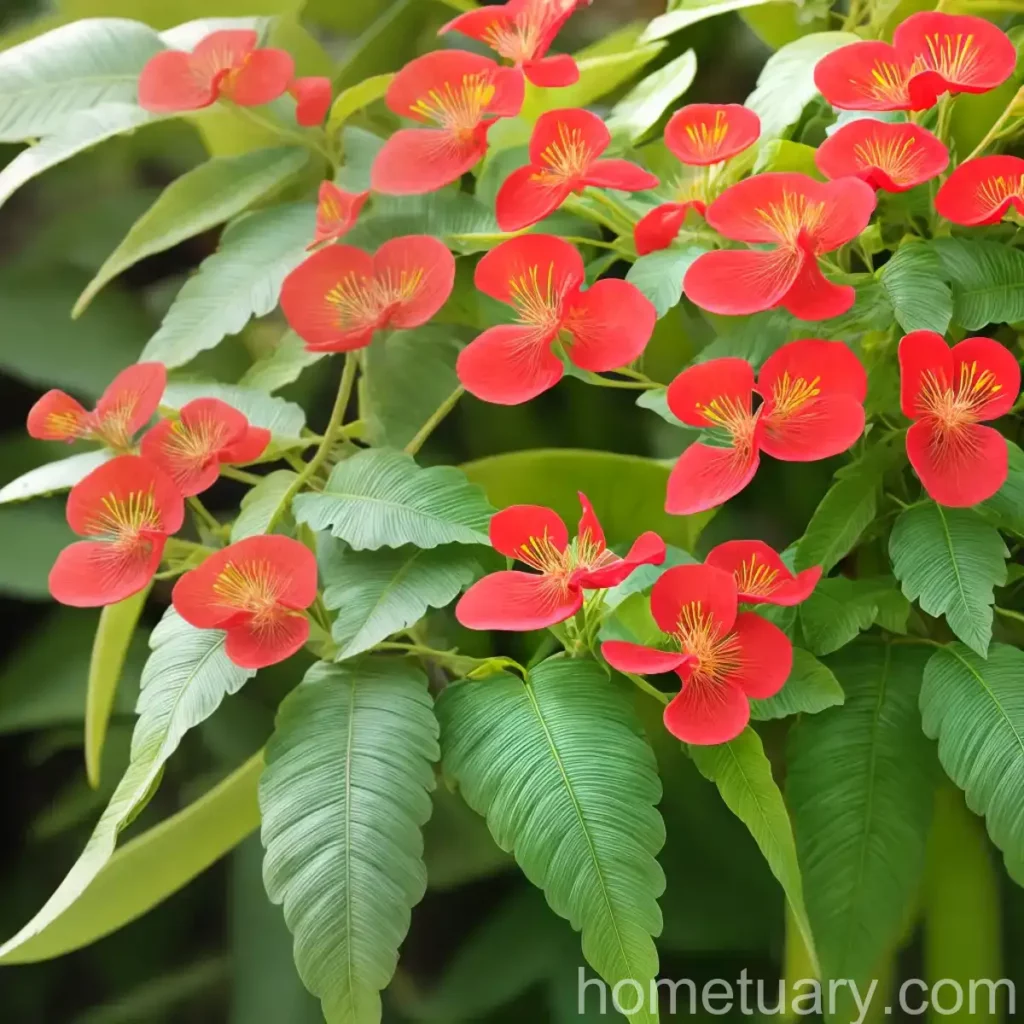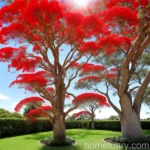The Enigmatic Divi-Divi Tree (Caesalpinia coriaria)
The field of botany is rich with diverse and fascinating plant species that not only contribute to the beauty of our planet but also offer an array of cultural, ecological, and medicinal benefits. In this blog post, we will delve into the world of the divi-divi tree (Caesalpinia coriaria), also known as the “Nance” in the Spanish language, to explore its unique characteristics, uses, and ecological significance. This plant holds immense potential for sustainable living, traditional medicine, and landscaping, making it a captivating subject of study for plant enthusiasts and scientists alike.
What is the Divi-Divi Tree (Caesalpinia coriaria)?
The divi-divi tree, scientifically known as Caesalpinia coriaria, is a species of flowering plant in the pea family, Fabaceae. This intriguing tree is native to the Caribbean, Central and South America and is characterized by its distinctive twisted and gnarled trunk, which gives it a unique and elegant appearance. The scientific name “Caesalpinia” is a homage to the renowned Italian botanist Andrea Cesalpino, while “coriaria” refers to the tanning properties of the plant’s bark.
The divi-divi tree typically thrives in arid and semi-arid environments, displaying remarkable resilience to harsh climatic conditions. Its ability to flourish in challenging habitats makes it an invaluable species for promoting biodiversity and ecological stability in such areas.
Key Takeaways – Divi-Divi (Caesalpinia coriaria)
Before delving into the specifics of the divi-divi tree, let us briefly summarize the key takeaways of this remarkable plant:
- Scientific Name: Caesalpinia coriaria
- Common Names: Divi-Divi, Nance
- Family: Fabaceae (Pea family)
- Habitat: Native to the Caribbean, Central and South America
- Distinctive Feature: Twisted and gnarled trunk
- Uses: Traditional medicine, tanning, landscaping, ecological conservation
- Ecological Significance: Resilient in arid environments, supports biodiversity
With this overview in mind, we will now explore the various aspects of the divi-divi tree, encompassing its cultural significance, ecological role, traditional uses, and cultivation practices.
Culture
The divi-divi tree holds cultural significance in the regions where it is native. Its unique appearance and resilience have captured the imaginations of local communities, leading to various folklore and traditional ceremonies associated with the plant. The elegant and twisted form of the divi-divi tree has inspired stories and allegories, contributing to its prominence in local cultures and folklore.
Divi-Divi Tree Symbolism
In some cultures, the divi-divi tree is regarded as a symbol of resilience and adaptability due to its ability to thrive in harsh and arid environments. This symbolism has been embraced in local folklore, where the tree is often depicted as a representation of strength and determination in the face of adversity.
The distinct shape of the divi-divi tree, with its twisted and contorted trunk, has also been interpreted as a metaphor for endurance and flexibility, further adding to its symbolic value in cultural narratives.
Uses
The divi-divi tree offers a plethora of uses that range from traditional medicine to ecological conservation and tanning. Its multifaceted nature makes it a valuable resource for sustainable living and environmental preservation.
Medicinal Properties of Caesalpinia Coriaria
The divi-divi tree has a long history of traditional medicinal uses, with various parts of the plant being employed for their therapeutic properties. The bark, leaves, and fruits of the divi-divi tree contain bioactive compounds that have been utilized in traditional healing practices.
In traditional medicine, extracts from the divi-divi tree have been employed for their anti-inflammatory, antimicrobial, and antioxidant effects. The bark, in particular, has been used to prepare decoctions and infusions for treating a range of ailments, including gastrointestinal disorders and skin conditions.
Traditional Uses of Caesalpinia Coriaria
Apart from its medicinal uses, the divi-divi tree holds cultural and practical significance in local traditions. The tannins present in the bark of the divi-divi tree have been harnessed for centuries to tan leather, a process vital for producing durable materials in traditional craftsmanship.
In addition, the fruits of the divi-divi tree, known as “Nance” in some regions, are consumed as a traditional delicacy, revered for their sweet and tangy flavor. The fruits are often used in culinary preparations, such as jams and beverages, adding to the diverse traditional uses of the plant.
Water
As a hardy plant accustomed to arid and semi-arid environments, the divi-divi tree demonstrates remarkable resilience to drought conditions. This inherent adaptability allows the plant to thrive with minimal water availability, making it an ideal species for landscapes in arid regions. However, during the initial stages of growth, young divi-divi trees may require moderate watering to establish strong root systems and promote healthy growth.
Sunlight
The divi-divi tree flourishes in full sunlight, exhibiting a preference for bright and unobstructed exposure to the sun. This characteristic aligns with its natural habitat in arid and open landscapes, where the plant has evolved to harness the energy of the sun for photosynthesis and overall vitality.
Climate Requirements
The climate requirements of the divi-divi tree are closely associated with its natural habitat, characterized by arid and semi-arid conditions. The plant thrives in regions with high temperatures and abundant sunlight, displaying adaptability to harsh climatic conditions. These traits make the divi-divi tree an excellent candidate for landscaping in dry and sunny environments, where it can contribute to the creation of vibrant and resilient green spaces.
Fertilizer
When cultivating divi-divi trees, minimal fertilization is generally sufficient, given the plant’s ability to thrive in nutrient-poor soils. In cases where the soil quality is suboptimal, the application of a balanced, slow-release fertilizer during the plant’s active growing phases can support healthy development and vigor. It is important to ensure that the fertilizer is applied sparingly, as excessive nutrients may negatively impact the resilience and natural characteristics of the divi-divi tree.
Soil
The divi-divi tree exhibits a preference for well-draining soils, particularly those with sandy or loamy textures. These soil types mirror the native habitats of the plant, providing the optimal conditions for root development and moisture regulation. Soil pH levels ranging from slightly acidic to slightly alkaline are generally suitable for the divi-divi tree, allowing for versatile cultivation across a range of soil compositions.
Pruning
Pruning practices for the divi-divi tree are primarily aimed at maintaining its elegant form and managing its growth. As the tree matures, periodic pruning may be performed to remove dead or damaged branches, enhance structural stability, and promote overall aesthetics. Additionally, gentle pruning during the early stages of growth can shape the tree and guide its development, contributing to the desired appearance and functionality in landscaping settings.
Propagation
The propagation of divi-divi trees can be achieved through seeds or cuttings, with each method offering distinct advantages for cultivation. Seeds from mature divi-divi fruits can be collected and germinated to establish new plants, while cuttings from healthy stems can be utilized to propagate genetically identical clones. Both approaches necessitate careful attention to planting conditions, such as moisture levels, temperature, and light exposure, to ensure successful establishment and growth.
Seed Germination
When germinating divi-divi tree seeds, it is beneficial to scarify the seed coats to promote efficient water absorption and germination. Scarification methods, such as abrasion or soaking, can help overcome dormancy and facilitate the emergence of healthy seedlings. Once the seeds have been prepared, they can be planted in well-draining soil and provided with adequate warmth and moisture to encourage vigorous germination and initial growth.
Container Popularity
The horticultural appeal and adaptability of the divi-divi tree make it a popular choice for container cultivation in diverse settings. Its distinctive and ornamental appearance, coupled with its resilience to drought and high light conditions, render it an attractive option for container gardening, urban landscapes, and horticultural displays. The divi-divi tree thrives in containers, provided that the appropriate soil, sunlight, and watering routines are meticulously maintained to support healthy growth and vitality.
Divi-Divi Tree as a Landscaping Plant
In landscaping, the divi-divi tree contributes to the creation of picturesque and sustainable environments, adding a unique element to outdoor spaces. Its twisted trunk and graceful foliage enhance the visual appeal of gardens, parks, and public areas, while its minimal water requirements and resilience to arid climates make it an invaluable asset for sustainable landscaping initiatives.
Common Diseases
The divi-divi tree is generally resilient to most common diseases, owing to its adaptation to arid and semi-arid environments. However, like all plants, it may be susceptible to certain pests and environmental stressors that can compromise its health and vigor. Identifying potential diseases and promptly implementing appropriate management measures is essential for safeguarding the wellbeing of divi-divi trees and ensuring their continued vitality.
Disease Diagnosis
Diagnosing diseases in divi-divi trees requires a keen eye for detailed symptoms and an understanding of common plant pathogens. Visual cues such as leaf discoloration, wilting, and abnormal growth patterns can provide valuable insights into the presence of diseases or pests. Additionally, consideration of environmental factors and cultural practices is crucial in establishing an accurate diagnosis and formulating effective treatment strategies.
Common Pests
While the divi-divi tree is known for its resilience, it may occasionally encounter pests that can impact its health and growth. Common pests that may affect divi-divi trees include aphids, mealybugs, and scale insects, which can colonize the foliage and stems, compromising the plant’s vigor.
Implementing integrated pest management strategies, such as regular monitoring, biological control agents, and targeted pesticide applications, can help mitigate pest pressures and preserve the health of divi-divi trees. Additionally, fostering natural predator populations and optimizing growing conditions can contribute to pest resilience and overall plant vitality.
Botanist’s Tips
For individuals enthusiastic about cultivating divi-divi trees or incorporating them into botanical collections, the following tips can offer valuable guidance and insights for successful growth and care:
- Adaptability: Embrace the innate adaptability of divi-divi trees and explore innovative methods for incorporating them into unique horticultural settings, in adherence to their ecological preferences.
- Observation: Cultivate a keen sense of observation to monitor the health and development of divi-divi trees, identifying signs of stress or optimal growth to inform appropriate interventions.
- Conservation: Recognize the conservation value of divi-divi trees and actively promote their sustainable cultivation and utilization to support ecological balance and biodiversity conservation.
Fun Facts
The world of plants often unveils intriguing facts and phenomena that capture our imagination and deepen our appreciation for the natural world. Here are some fun facts about the divi-divi tree that shed light on its captivating characteristics and ecological significance:
- The twisted and contorted forms of divi-divi trees result from their adaptation to prevailing trade winds, a unique natural phenomenon that shapes their growth patterns.
- Divi-divi trees are known for their resilience to adverse environmental conditions, displaying remarkable adaptability to arid and semi-arid climates.
- The bark of the divi-divi tree contains tannins that have been historically utilized in tanning processes, providing durable and long-lasting materials for traditional craftsmanship.
Links to External Resources
To further enrich your understanding of the divi-divi tree and explore its diverse facets, the following resources offer valuable insights and in-depth information on this captivating species:
- Caesalpinia Coriaria Uses and Benefits
- Divi-Divi Tree Facts and Characteristics
- Caesalpinia Coriaria in Traditional Medicine
- Cultivation of Divi-Divi Trees
The diverse aspects of the divi-divi tree, ranging from its cultural significance and traditional uses to its ecological resilience, showcase the invaluable contributions of this remarkable plant species. By delving into its unique characteristics and exploring its potential for sustainable living and ecological conservation, we can gain a deeper appreciation for the intricate relationships between plants and human societies, as well as their pivotal role in promoting biodiversity and environmental sustainability.















